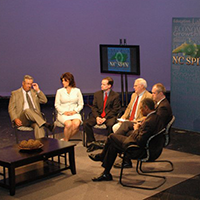The fever has broken
Published September 5, 2024
By Thomas Mills
This weekend, I took a drive through a rural Brunswick County precinct where Trump won by 50 points in 2020. I toured Varnumtown, Supply and two RV parks. Four years ago, virtually every yard sported a Trump sign and Trump flags proudly waved above dozens of motor homes in a muscular show of support. This year, I saw very few Trump yard signs and even fewer Trump flags. The difference is stark.
Don’t get me wrong. I know that almost every one of the people living in those houses would vote for Trump if they make it to the polls. I’m just not sure as many will get to the voting booth this year. The obvious enthusiasm of 2020 is gone. I drove one stretch of winding road past dozens of houses for more than five miles and one sad, outdated Trump-Pence sign was the only evidence of support for the former president. It feels like the fever has broken.
Since the country elected Obama, Republican turnout in elections in North Carolina has skyrocketed, dramatically outpacing Democrats. According to data from the state board of elections, GOP turnout increased by more than eight percent from 73.4% in 2008 to 81.6% in 2020. Democrats, in contrast, grew from 73.6% in 2008 to 75.1% in 2020, a mere 1.5% improvement. In 2012 and 2016, Democratic turnout fell while Republican turnout rose. By the time of Trump’s re-election campaign, Republicans had the advantage of a 6.5% enthusiasm gap over Democrats in North Carolina.
This year, Democrats are more motivated, at least so far. According to Gallup, the party is more excited about voting than any time since 2008. Their poll last week indicates 78% of Democrats say they are “more enthusiastic than usual about voting.” Only 64% of Republicans say the same.
Enthusiasm fuels field operations and GOTV. It drives volunteers to sign up for door knocking and phone banking. It creates an infectious atmosphere that makes people want to be part of the excitement. In 2020, that excitement was visible in the Trump signs that littered Brunswick County. This year, it’s evident in the packed rallies of Kamala Harris and Tim Walz.
In North Carolina, Democrats need an army of supporters to get their people to the polls. If they have one, the party can win the state in three easy steps. Ok, maybe not so easy, but very possible with a bit of hard work. Their key to victory lies with increasing turnout among younger voters and African Americans and winning women voters by a larger margin than in 2020. These also happen to be the groups most motivated by Kamala Harris’ candidacy.
Democrats should assume that Republicans will turnout at levels similar to 2020. Back then, 83% of voters over 40 years old showed up, almost 82% of registered Republicans cast a ballot, and 79% of registered white people voted. Those percentages are historically high and there’s no indication that they will increase this year. Even with these numbers, Trump won by less than 75,000 votes out of 5.5 million cast.
Democrats need to first and foremost close the gap with young people. Voters under 40 years old lagged their elders by about 20%. Younger voters will never vote at the rate of older voters, but Democrats need to narrow that gap substantially. In 2008, when Obama won, the gap was about 10%.
Next, Democrats need to increase African American turnout. While Black turnout rates reached into the low-70s in the Obama years, it dropped to 64% in 2016 and only reached 68% in 2020. This year, Democrats need to drive African American turnout back into the mid-70s.
Finally, women voters favor Democrats and make up a larger share of the electorate than men. According to 2020 exit polls of North Carolina, women preferred Biden over Trump by a 7% margin while men chose Trump by an 11% margin. Democrats need to use reproductive rights to close that gap while driving more younger women to the polls.
A bonus step would be winning Hispanic voters by 15 points like Democrats did four years ago. They are the fast growing demographic in the state, making up almost a third of the new registrants since 2020. Their continued support could solidify North Carolina as an emerging blue state.
Democrats have a clear path to victory in North Carolina and maybe more than one. Republican turnout likely reached its peak in 2020. Even if it stays as high this year as four years ago, enthusiasm for the Harris-Walz ticket as well as a stellar council of state slate led by Josh Stein could give Democrats the momentum they need to win. They have the offices, the staff, and the volunteers. They just need to stay focused and motivated for two more months.
That said, I don’t believe Republican enthusiasm is strong enough to reach their 2020 high point. The ubiquitous yard signs from four years ago are gone. The flags aren’t flying. The fever seems to have broken. I expect their turnout will return to earth, too. Democrats need to press their advantage. Victory in North Carolina is in reach.
Thomas Mills is founder of PoliticsNC, a reader supported site







